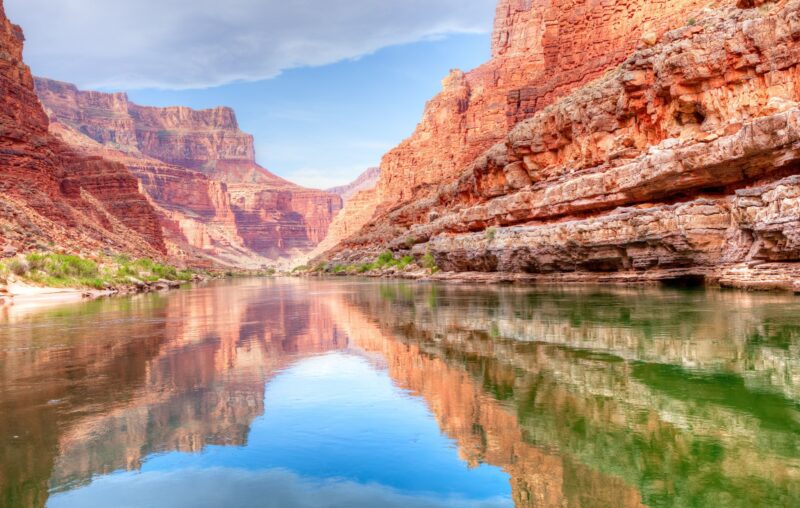How the Subsidy Straw Is Sucking The Colorado River Dry

The Colorado River has been facing a water crisis for over two decades. From 2000 to 2021, the river basin has “lost over 40 trillion liters of water.” Per a recent news report, water scarcity has led to disputes among the seven states sourcing water from the Colorado River.
While it’s heating up, the debate is nothing new. For years, states have contested their water allotments. Commentators are quick to look for the cause of the plummeting water levels, pointing to climate change or population booms in the southwest. The true culprit is less obvious.
The offender of the shrinking Colorado River is agricultural subsidies. A staggering 79 percent of the water harvested is for agricultural use; only 12 percent is for residential use. A combination of crop, irrigation, and crop insurance subsidies have formed a “subsidy straw” dipping into the river itself. These farming-sector entitlements have incentivized producers to grow thirsty plants, underpriced water extraction, and created moral hazard. To save the Colorado River, it is critical to end this water-guzzling trifecta.
Common sense declares we should avoid growing water-intensive crops in the desert. Crop subsidies allow farmers to cultivate water-gulping plants. Per the Cato Institute, the most heavily subsidized crops include: “corn, soybeans, wheat, cotton, and rice”. They also tend to be the crops that require the most water. The extra incentive to grow thirsty crops “discourages” farmers from rotating to water-conserving commodities, as they would if they bore a more significant part of water costs.
Subsidized water-guzzlers are top crops for arid states. For example, Arizona is renowned for its cotton production. It takes “5,283 gallons of water to produce 2.2 pounds” of cotton. Despite the water inefficiency, cotton producers have received over $1.1 billion in crop subsidies over the past few decades, sucking the Colorado River dry for the sake of an ailing industry.
If enticing farmers to grow water-gulpers wasn’t bad enough, the government also subsidizes irrigation equipment. The US government subsidizes “efficient” irrigation equipment to conserve water. In most cases, it has the opposite effect.
The irrigation initiative was intended to make water extraction less wasteful, but has only increased water consumption. Repeated studies find that upgraded irrigation equipment resulted in a 3-percent increase in water extraction. Researchers also discovered that “farmers were more likely to plant water-intensive” crops in “higher proportion of their fields” when irrigation was subsidized. Combined with the “use it or lose it” water rights policies and the illegality of selling excess water use privileges, farmers have no incentive to conserve. Despite the proven ineffectiveness of these irrigation subsidies, the Biden administration is still pouring millions into this counterproductive endeavor.
To top it off, producers also receive cheap crop insurance. Crop insurance policies typically cover agricultural goods damaged by drought. Farmers get a helping hand from the government, even if water supplies should fail. In 2022, Uncle Sam subsidized 62 percent of policyholders’ premiums, totaling a whopping $12 billion. Between 2000 and 2016 producers “received $65 billion more in claims than they paid in premiums.” Many tax dollars have propped up farms producing thirsty crops in the desert.
Making crop insurance cheaper will not help water-conservation efforts. If anything, it will create moral hazard by making drought less costly. Low insurance premiums do not incentivize farmers to switch to crops that require less water, nor to use less water. The government safety net makes them less likely to change their wasteful ways. If farmers were responsible for the full premiums or had no insurance, they would feel the pinch of water shortages, quickly adopting more efficient water-management strategies or growing crops that thrive in desert terrain.
Town ordinances banning lawn-watering will not save the Colorado River. Dissolving the “subsidy straw” and developing water markets might be the remedy. Subsidies have made water 10 times cheaper in Arizona than in Michigan. The ebbs and flows of uninhibited market prices ensure water is allocated to its higher-value uses (decreasing wasteful usage) and curbs demand during times of drought.
One of the great success stories of water markets has been in Australia’s Murray-Darling Basin (MDB). During the drought of 2019, the price of irrigation water increased by 140 percent from 2018. High prices will lower demand and motivate farmers to conserve and sell their surplus water.
Market prices are a natural safeguard against over-extraction. Prices for the MDB market are influenced by demand and environmental conditions impacting the water supply. The average cost in 2022-2023 was about $29 /ML. Because of drier conditions, the projected cost for 2023-2024 jumped to 175 percent. The inverse relationship between supply and demand is instrumental in stopping the overconsumption of water, or any naturally limited resource.
Crop, irrigation, and insurance subsidies have created the perfect storm for encouraging wanton water consumption in the agricultural sector, most destructively in America’s deserts. These practices waste not only water but an unending stream of tax dollars. If we want to solve the water crisis in the Western United States, these entitlements must go.











